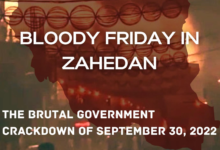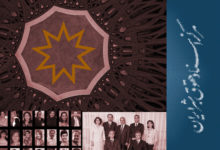Community Under Siege: The Ordeal of the Baha’is of Shiraz
The sentencing of twenty-two members of the Baha’i community of Shiraz to death for refusing to recant their faith in 1983 resulted in the largest mass execution of Iranian Baha’is since the Islamic Revolution. Many other members of the community were also imprisoned and abused. The ordeal of the Baha’is of Shiraz is emblematic of the treatment of the Baha’i Faith by the Islamic authorities in Iran. This report exposes the religious of intolerance of the Islamic Republic and puts a human face on the suffering of a community still under siege today.
Table of Contents
Contents
1. PREFACE
3. POLITICAL CONTEXT
3.1. EFFECTIVE CRIMINALIZATION OF THE BAHÁ’Í FAITH
3.2. TORTURE, EXECUTION AND FORCED DISAPPEARANCES
3.3. DESTRUCTION OF PROPERTY AND DESECRATION OF RELIGIOUS SITES
3.4. ECONOMIC AND SOCIAL DISCRIMINATION
3.5. RECENT DEVELOPMENTS
3.6. THE RELIGIOUS SIGNIFICANCE OF SHIRAZ
4. THE SHIRAZ TWENTY-TWO
4.1. THE OCTOBER ARRESTS
4.2. THE NOVEMBER ARRESTS
4.3. APPEALS FOR HELP
5. CRIMINAL PROCEEDINGS
5.1. BAZDASHT – THE PRELIMINARY INVESTIGATION
Individual Interrogations
Group Interrogations
Face-to-face interrogations
Use and threat of torture
5.2. BAZPURSI – THE JUDICIAL INVESTIGATION
5.3. THE TEHRAN DELEGATION
5.4. DADGAH – THE COURT
Recantations
5.5. KHABAR-I JUNUB ARTICLE
5.6. INTERNATIONAL PROTESTS
5.7. ISTITABIH – ‘RECANT OR DIE’
5.8. THE JUNE EXECUTIONS
6. AFTERMATH
6.1. IDENTIFYING THE BODIES
6.2. INTERNATIONAL CONDEMNATION
6.3. COVER-UP
7. CONCLUSION
8. METHODOLOGY
1. Preface
The Bahá’í community in Iran has long faced repeated cycles of persecution. The Shi’a clerical establishment in Iran has condemned the Bahá’í Faith as a heretical deviation from Islam; as the hometown of the Báb and one of the early centers of the Bahá’í Faith, the city of Shiraz in Fars Province has been a frequent flashpoint for these tensions.
The arrests that took place in Shiraz in 1982, and the subsequent announcement of the execution of twenty-two Bahá’í faithful the following year, are emblematic of the Bahá’í experience in the Islamic Republic. The oldest victim, Mr. Abdu’l-Husayn Azadi, was sixty-six years old and the youngest, Ms. Mona Mahmudnizhad, only seventeen years old. They found themselves pitted against the full weight of the Iranian state simply because of their religious beliefs.
The IHRDC report A Faith Denied: The Persecution of the Bahá’ís of Iran exposed the effective criminalization of the Bahá’í religion by the Islamic Republic; events in Shiraz provide a graphic illustration of how this narrative worked in practice. The head of the Revolutionary Court in Shiraz, Hojjatolislam Qaza’i, denounced the Shiraz twenty-two prior to their execution as “puppets of Satan and the superpowers and their agents such as the Universal House of Justice of Israel.” Their interrogators repeatedly accused the prisoners of nebulous acts of espionage for which they offered no proof. Ultimately, the Iranian regime would fall back on charges of espionage to justify the executions.
Religious persecution was the primary motive for the Shiraz arrests and murders. In custody the Bahá’í detainees were classified as ‘unclean’ by the prison authorities and forbidden physical contact with the general prison population, a prohibition which extended to their personal belongings. They were forbidden to worship openly or talk about their faith. Community leaders were singled out for torture. All the prisoners were placed under great pressure to recant their faith.
It would be tempting to dismiss events in Shiraz as a local aberration if it were not for the personal intervention of Ayatollah Khomeini in the case. As an international chorus of protest grew in volume, Ayatollah Khomeini dismissed pleas for clemency in a widely published speech casting the Bahá’ís as a political party rather than as a religion and the prisoners in Shiraz as nothing more than spies. The majority of the Shiraz victims were executed less than a month later.
The story of the Shiraz executions is one of religious devotion in the face of extraordinary pressure to convert. To this day, the government of Iran continues to refuse to recognize the Bahá’í Faith as a genuine religion and to extend Bahá’ís the same rights accorded to Christians, Jews and Zoroastrians in the Iranian constitution. It is our profound hope that this report will bring attention to the historic and ongoing oppression of a minority religious group in Iran and give the current regime in Tehran cause for reflection.
2. Executive Summary
The 1983 execution of twenty-two members of the local Bahá’í community in Shiraz is the single greatest episode of overt violence against Iranian Bahá’ís, but it is not anomalous. The case epitomizes many aspects of the Islamic Republic’s treatment of this domestic religious minority, including the refusal to accord the Bahá’í Faith the status of a religion while simultaneously pursuing the conversion of the Bahá’í faithful in a manner reminiscent of the methods of the Spanish Inquisition.
- As an early center of the Bahá’í Faith, Shiraz has repeatedly been the scene of conflict between the Muslim majority and the local Bahá’í community. During the Iranian revolution Bahá’í property was seized for use by the revolutionary authorities and the local Bahá’í cemetery desecrated. In February 1979 the suburb of Sa’diyeh was rocked by an anti-Bahá’í pogrom that left more than two hundred homes and businesses looted and burned.
- In April 1979, the Revolutionary Guards in Shiraz confiscated one of the holiest Bahá’í sites, the House of the Báb, and in September 1979 the property was completely razed to the ground. In 1981 the site was transformed into a road and public square which in turn gave way to the construction of a new mosque dedicated to the 12th Imam on the site.
- The new Islamic government also targeted individual members of the Bahá’í community in Shiraz. Five leading members of the community were executed in the first half of 1981. Three more were killed in 1982. In the autumn of 1982 local Revolutionary Guards conducted two rounds of mass arrests that further targeted the Bahá’í community. In October thirty-nine local Bahá’ís were detained. A second round of arrests in November swept up another forty-one local Bahá’ís.
- Although some detainees were released, others endured months of harsh interrogation at the hands of the Revolutionary Guards. The interrogators sought information about the Bahá’í community; they also sought to coerce the detainees into recanting their faith. In the case of the more prominent detainees this coercion included torture.
- In February 1983, the Revolutionary Court in Shiraz accidentally sent an internal circular intended for distribution within the Revolutionary Guard Corps to the offices of a local newspaper, Khabar-i Junub. The circular stated that the Court had issued an order for the execution of twenty-two members of the local Bahá’í community. The victims were not named. The newspaper published this information following it up with an interview with the Head of the Revolutionary Court, Hojjatolislam Qaza’i, ominously headlined: “I Warn the Bahá’ís to come to the Bosom of Islam.” At the time one detainee had already been executed in January. Three more prominent Bahá’í detainees were executed in March 1983.
- The Khabar-i Junub article provoked an international outcry. The Islamic Republic regime responded by exploiting the foreign pressure as evidence to support its narrative that the Bahá’í Faith was the artificial creation of the superpowers with the aim of undermining Iranian society. In a widely reported speech in May 1983 Iran’s Supreme Leader, Ayatollah Khomeini, dismissed international protests with the comment: “Were these people not spies, you would not be raising your voices.”
- At the beginning of June 1983, in accordance with Islamic tradition, the remaining Bahá’í detainees were offered four last opportunities to convert to Islam and save their lives. They all declined. Six male detainees were executed on June 16. Ten female detainees were hanged in Shiraz’s Chawgun Square on June 18. Of the two remaining male detainees who died in 1983, one was executed at the end of June and the other died while in prison custody.
- Although the Iranian authorities have never explicitly named the Shiraz twenty-two, the IHRDC has identified twenty-two Bahá’í detainees who died in 1983 in the custody of the Shiraz authorities. Twenty-one were executed and one victim died in prison after months of abuse. We believe that it is reasonable to conclude from the existing evidence that it was the original intention of the Shiraz Revolutionary Court that all twenty-two be executed for their refusal to recant their faith.







